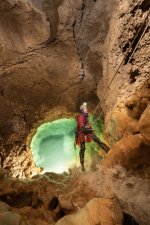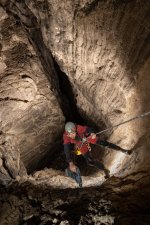adventurebarbie
Active member
Hey all,
Just an update really to say that the ACP expo is back after a few quiet covid years.
This year we're finally back into C4 to continue the many upstream leads and to continue climbing a few impressive shafts.
and also as a very special treat we're going back into Cabexa Muxa.
Cabeza Muxa was last visited by a UK team in 1988 when at the bottom of the 900m deep cave the downstream sump (water filled passage) was dived by Rick Stanton to a depth of 33m using scuba gear. It has remained unexplored since then and offers the potential for a significant hydrological connection. The cave contains the largest stream way in the area and the water here is believed to drain to Cueva Culiembro in the Cares Gorge. The end of Sima Cabeza Muxa and Culiembro are about 1,500m apart with a height difference of about 200m. We will plan on re-rigging Cabeza Muxa to facilitate continued cave diving exploration in the downstream sump using closed-circuit rebreather technology. Exploration of the Sima Cabeza Muxa watercourse could provide an important connection between two major deep caves in the area and this would allow a fuller understanding of the hydrological connections and drainage in the region. In turn, this will support and enable future exploration efforts in the area as part of the multi-generational effort to map and understand the cave systems of the Ario plateau.
C4 was first explored in 1996 and 1997 and became the focus of the 2015-2017 expeditions. Finally, in 2017 a major breakthrough was made when the cave, which drops into a major stream way called ‘Underground Overdrive’ was connected to the main watercourse in another cave called ‘2/7’. Upstream C4 has split into a number of passages, chambers and avens, many of which are ongoing and should allow a connection with other important caves in the area as well as other potholes feeding into the upstream end of the system. With several ongoing passages, much work remains to be done in upstream C4 in search of the ‘Ario Dream’
Just an update really to say that the ACP expo is back after a few quiet covid years.
This year we're finally back into C4 to continue the many upstream leads and to continue climbing a few impressive shafts.
and also as a very special treat we're going back into Cabexa Muxa.
Cabeza Muxa was last visited by a UK team in 1988 when at the bottom of the 900m deep cave the downstream sump (water filled passage) was dived by Rick Stanton to a depth of 33m using scuba gear. It has remained unexplored since then and offers the potential for a significant hydrological connection. The cave contains the largest stream way in the area and the water here is believed to drain to Cueva Culiembro in the Cares Gorge. The end of Sima Cabeza Muxa and Culiembro are about 1,500m apart with a height difference of about 200m. We will plan on re-rigging Cabeza Muxa to facilitate continued cave diving exploration in the downstream sump using closed-circuit rebreather technology. Exploration of the Sima Cabeza Muxa watercourse could provide an important connection between two major deep caves in the area and this would allow a fuller understanding of the hydrological connections and drainage in the region. In turn, this will support and enable future exploration efforts in the area as part of the multi-generational effort to map and understand the cave systems of the Ario plateau.
C4 was first explored in 1996 and 1997 and became the focus of the 2015-2017 expeditions. Finally, in 2017 a major breakthrough was made when the cave, which drops into a major stream way called ‘Underground Overdrive’ was connected to the main watercourse in another cave called ‘2/7’. Upstream C4 has split into a number of passages, chambers and avens, many of which are ongoing and should allow a connection with other important caves in the area as well as other potholes feeding into the upstream end of the system. With several ongoing passages, much work remains to be done in upstream C4 in search of the ‘Ario Dream’





